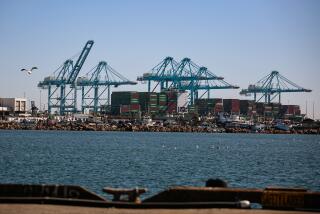No Criminal Case to Be Filed Against Nassco in Accident That Killed 6
- Share via
No criminal charges will be filed against the National Steel & Shipbuilding Co. or the man who was operating the crane when a steel basket carrying 12 men plunged 30 feet to the deck of a Navy ship, killing six and injuring the others.
In a report released Friday afternoon, San Diego County Dist. Atty. Edwin Miller said that his investigation was unable to pinpoint blame for the July 10, 1987, accident. The investigation, which was begun at the insistence of the shipyard unions, also failed to show that Nassco or operator Hugh Humphrey was reckless or negligent in operating the crane.
Miller’s report ruled out mechanical failure as the cause of the accident, but it raised the possibility that Humphrey might have “inadvertently” caused the accident by failing to use the crane’s foot brake while transporting the personnel basket.
“Absent some indication of deliberate conduct on the part of the operator . . . it can reasonably be concluded that the accident resulted from the operator inadvertently disengaging the clutch and failing to use the foot brake,” the four-page report said.
The report also emphasized that the cause of the accident may never be known.
“The exact cause of the accident has not been determined, and may never be determined. . . . Even if we could prove the cause of the fatalities beyond a reasonable doubt, the provable conduct in this case still falls far short of that which is criminally proscribed,” the report said.
Humphrey could not be reached for comment. The injured workers and the survivors of the workers who were killed have sued the crane manufacturer and the shipyard in federal court.
The report noted that Humphrey, 66, has operated cranes for 45 years. However, until the accident, Humphrey had mostly operated conventionally powered hydraulic cranes that move on the ground. The crane involved in the accident is called a gantry, runs on a fixed track and is powered by a diesel engine that generates electricity to run the boom.
Humphrey was involved in another fatal shipyard accident in 1986, when a load he was carrying fell, killing one worker.
OSHA Findings
Miller decided not to file criminal charges against Nassco despite findings by the federal Occupational Safety and Health Administration that the crane was not designed or equipped to transport people. OSHA investigated the accident and proposed $62,800 in fines and 19 citations against Nassco. The shipyard contested most of the fines and citations.
In April, John Hermanson, director of the OSHA office in San Diego, said “that crane was not equipped to meet the requirements that are outlined in those standards” for cranes used to transport personnel.
“We’re talking about equipment that was, or was not, on the crane itself, equipment necessary to transport people,” Hermanson said in an April interview. “It’s a combination of the way the crane was equipped, I assume from the factory, and procedures and policies not developed by Nassco.”
After the accident, Nassco officials established a written policy to govern the use of cranes and personnel baskets. Use of personnel baskets is not prohibited, but their use must be cleared in advance by Nassco’s president or senior vice president.
Attorney Preston Easley, who is representing four workers who survived the Nassco accident and the survivors of another who died, alleged in April that the crane was hampered by a missing automatic backup system to brake a falling load.
Easley, a personal injury attorney who specializes in maritime accidents, also alleged that a mechanical brake that can be used manually to prevent a load from falling while the crane boom swings out with the load was out of Humphrey’s reach.
The district attorney’s report did not address the discrepancies noted by Hermanson or Easley. Herman and Easley could not be reached for comment.
More to Read
Sign up for Essential California
The most important California stories and recommendations in your inbox every morning.
You may occasionally receive promotional content from the Los Angeles Times.













